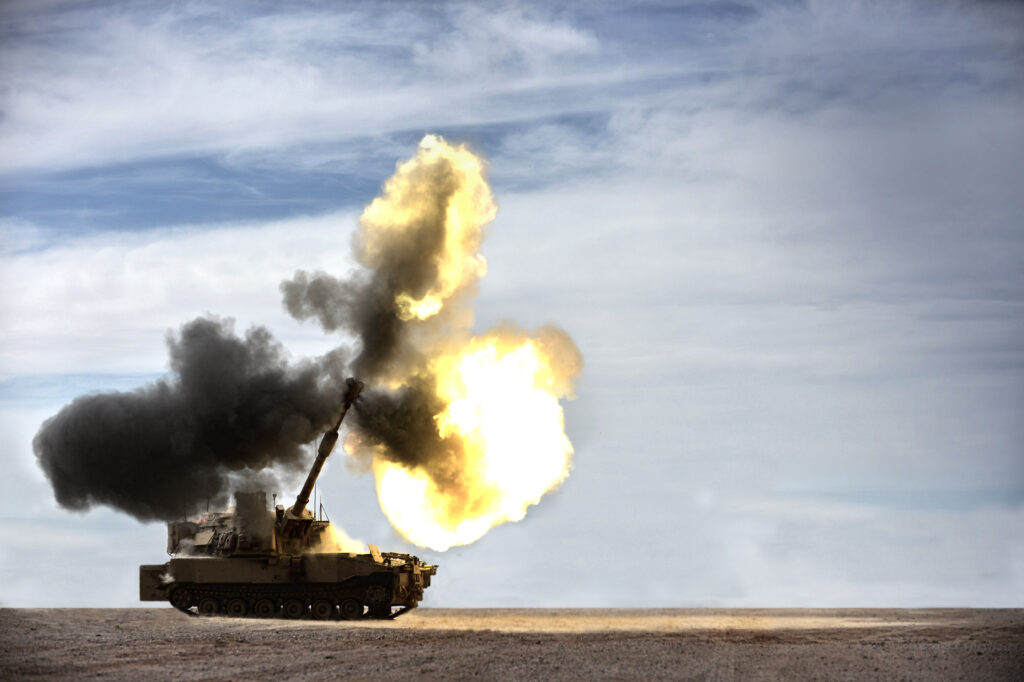
M109A7 Paladin fires during a test in Yuma, Arizona
WASHINGTON: Army experiments have shortened the kill chain remarkably – from the time a satellite or drone detects a target to the time an artillery unit opens fire – to “less than 20 seconds,” the head of Army futures Command said this afternoon.
When you’re fighting an enemy like Iraq, “it was probably okay to take tens of minutes between identifying a target and actually putting round on that target,” Gen. Mike Murray told a Center for a New America Security webcast. But in a future fight against “our near-peer threats, both Russia and China… it’s not going to be tens of minutes.”
The Army’s Project Convergence wargames at Yuma Proving Ground will test a kill chain this fall combining Army and non-Army assets, Murray said:
- Sensors: Targeting data will come from satellites in Low Earth Orbit – “not Army-owned, [but] joint and really interagency,” Murray said – as well as Army Grey Eagle drones and sensors on the ground.
- Command & Control: That data will flow into a C2 hub at Joint Base Lewis-McChord in Washington, where it’ll be processed and analyzed by what Murray called “a developmental program” – almost certainly some form of artificial intelligence able to sort through information far faster than human staff officers. (McChord is also home to the Army’s first-ever Intelligence, Information, Electronic Warfare, & Space (I2CEWS) battalion, whose raison d’être is long-range targeting for both physical and cyber weapons, though Murray didn’t say whether or not they were involved). The C2 node then calculates the best weapon to destroy that specific target.
- Shooters: “We’ll put rounds on target from either a [M109] self-propelled howitzer, or from a Grey Eagle, or from a ground platform,” he said.
From beginning to end, satellite to shots fired, Murray said, “right now, we have some success doing that in less than 20 seconds.”

Gen. John “Mike” Murray
‘Very Immature Technologies’
As head of Army Futures Command, Murray oversees development of 34 high-priority systems programs across six broad portfolios: long-range precision artillery, high-speed aircraft, armored vehicles, the tactical network, air & missile defense, and soldier gear. Project Convergence stems from the Army’s realization last year that, since all of these weapons need to work together on the future battlefield – and preferably as much more than the sum of their individual parts – Futures Command needed to start testing how they’d work together as early as possible in their development.
“We have… almost no programs of record at Yuma,” Murray said. “These are very immature technologies that we’re piecing together to understand potential, to understand what soldiers can do and really what commander can make out of these tools.”
It’s a tremendous work in progress. “Part of the magic out at Yuma is there are people recoding software every night to fix problems — and I see that on a future battlefield,” Murray said. “Brigade commanders and division commanders – if we [still] have brigades and divisions — are going to have kids in their command posts that are able to re-code software to solve problems they came up with that day.”
As the director of the Joint AI Center told me in a recent interview, software can adapt to new threats and opportunities vastly faster than you can upgrade your physical weapons. So in this software-driven way of war, constantly changing your code isn’t a bug – it’s a feature.
It’s not just the Army that needs to connect this way, either. All the services are striving to link together in a single Joint All-Domain Command & Control (JADC2) meta-network, an idea of increasing interest to US allies as well.
While the inaugural Project Convergence this fall will be largely Army, with the significant exception of the LEO satellites, observers from the Air Force and Great Britain will be present. Project Convergence 2021 will be “very much focused on bringing the joint force in,” Murray said, and 2022 will bring in foreign partners. “The UK is signed to participate in ’22 and they will be there this year [observing],” he said. “The Australians are talking about participating in ’22.”
But the new network will never be omniscient and omnipresent, Murray warned, not just because of real-life technical limitations but because enemy jamming and hacking will actively attack its communications links.
“JADC2 [has] been described variously as all sensors, all shooters, all C2 nodes,” the general said. “I think it’s a little more narrow than that, because we’re going to be in a contested environment, restricted bandwidth. We just won’t have wide open pipes to push data through.”
Connecticut lawmakers to grill Army, Lockheed about job cuts at Sikorsky helicopter unit
“The Connecticut delegation has questions about why, with that [FY24] appropriation in hand, this happened,” said Rep. Joe Courtney, D-Conn.


























